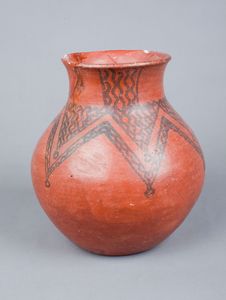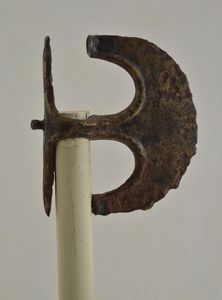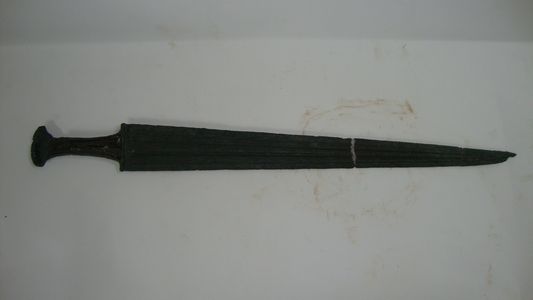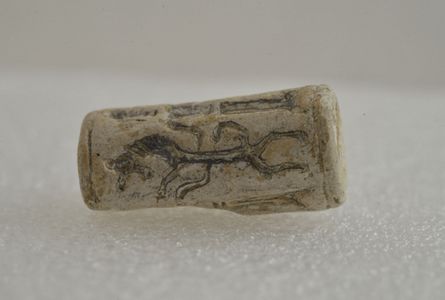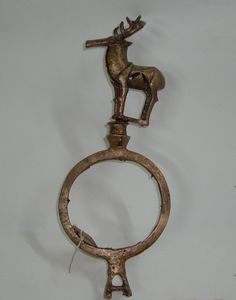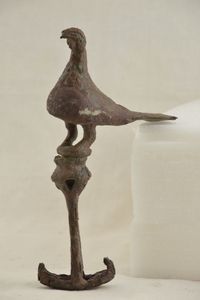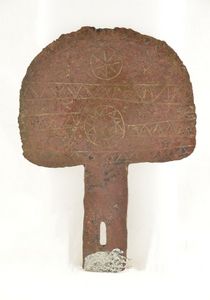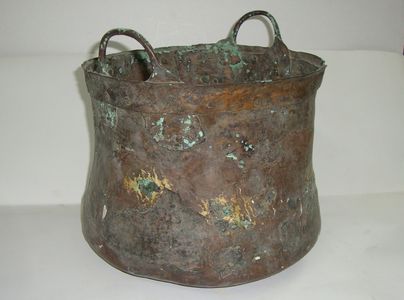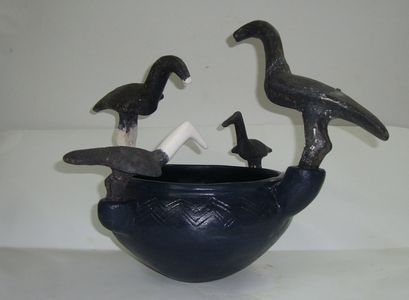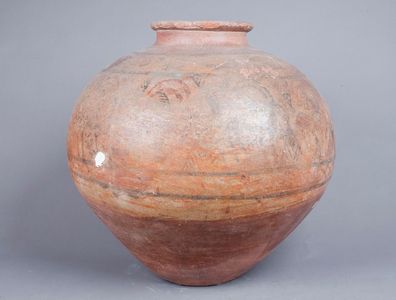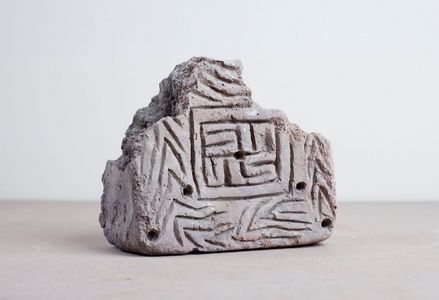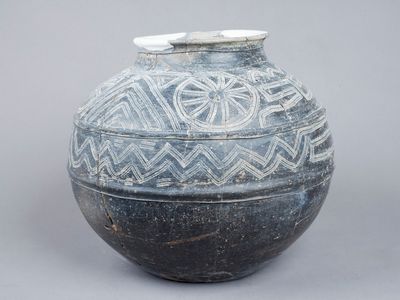AZERBAIJAN DURING MIDDLE BRONZE AGE
Middle Bronze Age
Lasting between III and II millenniums B.C., Middle Bronze Age was characterized by the diversification of single material culture that had been previously shared by all tribes living in the territory of modern Azerbaijan, and the emergence of local cultures with limited geographic coverage. Among others, those changes manifested themselves in the construction of right-angled buildings and the production of diverse pottery items. For example, Middle Bronze Age earthenware artefacts from the southern part of Azerbaijan are red and decorated with paint ornaments, while similar items from the north are dark-gray and decorated with carved ornaments.
Settlements
Middle Bronze Age heritage of Azerbaijan is represented by the monuments located in Nakhchivan, Kur-Araz interfluve, Urmia Lake’s basin, Garabagh lowland, Mughan, Gobustan, Absheron and other regions of the country. Houses on Nakhchivan I and Kultapa I sites have rectangular plans. Kultapa I settlement covered the territory of 3 ha. One third of its area was surrounded by 2 m thick fortification wall with towers and counterforts, constructed of large square bricks over the cemented stone basement. On later stages, houses were built of the cemented stones and sometimes consisted of several rooms. Monuments of that period were discovered in a number of monuments, including Shortepe site in Barda, Rasultepe, Goytepe and Chinartepe sites in Aghdam, and Chaggallitepe site in Aghjabadi districts of modern Azerbaijan.
Uzarliktepe site is covers 3 ha large area in the eastern outskirts of Aghdam. The settlement was surrounded by 2 m thick defensive walls built of large square bricks. On the eastern wall, there was an entry to the settlement. Outer wall of the entry was supported by right-angled counterforts.
First tribal confederations and intertribal relations
In the beginning of Middle Bronze Age, pastoralist tribes played a leading role in the period’s intertribal relations. That period was marked by the emergence of seminomadic pastoralism, development of metalworking crafts and establishment of close relations with the Western Asia’s first urban civilizations. These factors had considerably increased the workforce productivity and production surplus, deepened social stratification and caused profound changes in the economic, political and cultural life of the region’s tribes. All these changes had affected the ethnic processes, too. As demonstrated by the outcomes of archaeological studies, the described period was characterized by demographic growth, emergence of tribal confederations, complication of intertribal relations and increased frequency of armed conflicts.
Written sources of XXIII century B.C. provide some information on Gutians, Lullubis, Hurrians and Kassites - tribal confederations which lived in the Southern Azerbaijan and its adjoining territories. Each of these confederations united tribes that had lived in the neighboring territories, spoken different dialects of the same language and shared common cultural values.
Thanks to their close relations with the other parts of Western Asia region, tribes of the Middle Bronze Age Azerbaijan benefited from new technical and cultural achievements of the period’s advanced civilizations with which they had established a cultural exchange. Benefits of such relations include but are not limited to the production of paint earthenware items on potter’s wheels, usage of donkeys and coach-horses, and spreading of pipe-spears, framed sward grips and different Western Asian adornments.
Tugs (banners)
Special place in the material heritage of the Bronze Age Azerbaijan is occupied by the tugs – symbols of power which used to be mounted on war chariots. One of such tugs is the tug discovered in Shamkir district among the artefacts of Garajamirli kurgan. Made of a cast iron, the tug consists of a deer figure and ring.
MIDDLE BRONZE AGE: ECONOMY AND CRAFTS
Horticulture and pastoral farming
Main sectors of the Middle Bronze Age economy were horticulture and pastoral farming. Horticulture was the main activity area of tribes populating lowlands and valleys of rivers. Farmers tilled soils with wooden ploughs, used wooden sickles with stone teething to gather the harvest, and stone mortars, graters and handles to grind the grains. Some settlements grew on fertile lands and close to the sources of water, which apparently means that they had developed irrigation cropping systems. There is a big variety of burnt crop remains discovered from the places of residence ruins during the archeological excavations.
Regardless of how important the role of horticulture was in the development of sedentary people, it always developed together with pastoral farming. As demonstrated by the materials collected from Uzarliktepe site, inhabitants of this Middle Bronze Age settlement used to raise plenty of great and small cattle. Presence of pig bones among the site’s archaeological findings leads us to a conclusion that the settlement residents had access to high-quality pastures and practiced transhumance pastoralism. Among Kultepe II artefacts there are bones of great and small cattle, as well as horses and donkeys. The settlement is known as the first site in the entire South Caucasus region, where donkeys had been used in the household economies.
Metalworking and pottery
Middle Bronze Age was the period when metalworking entered a new stage of its development, and when previously unknown types of the implements, arms and adornments were invented by using innovative production technologies. In that period, blacksmiths started adding new elements to a molten bronze material, e.g. tin (5-10%), arsenic, antimony and mercury. Main raw materials were extracted from local deposits and there were smitheries in evert human settlement.
Smithery related artefacts of the described period include copper smelting residues discovered on Uzarliktepe site, clay ladles found on Kultepe II and Gobustan Boyukdash sites, and stone mould used for casting the arrowheads discovered on Haftavan site. List of discovered bronze artefacts includes axes, spearheads, sword blades, hooks, copper pots, four-edge awls, a lot of buttons, biconical antimony beads, golden and silver pendants, etc. If the arms and implements were manufactured by the method of casting, adornments continued to be prepared based on the models made from wax or other easily melted materials.
Another type of the Middle Bronze Age crafts was pottery. In that period, production of paint crockery was widely developed in the areas around Urmia Lake, as well as in Kur-Araz lowland and Nakhchivan. Pottery items had been produced both manually and with the potter’s wheel help. On the other hand, communities of the northern districts and the Caspian coast preferred manually produced crockery decorated with different carved or engraved ornaments, e.g. arched figures, inlaying semicircles, dash and wavy lines, meanders and curves. Sometimes pottery items were also decorated with incised ornaments.
Paint crockery culture: pitcher from Shahtakhti
Paint crockery items from the areas of Urmia, Kur-Araz lowland and Nakhchivan were usually decorated with monochrome paintings. However, there are some examples of polychrome decorations, too. Upper halves of such artefacts were usually decorated with geometrical ornaments painted over red or yellow coloured engobe. Also, there are extremely rare artefacts which had been decorated with zoomorphic ornaments. One of such items is the pitcher discovered in 1936 from Shahtakhti necropolis. Outer surface of the pitcher is divided into three horizontal strips decorated with polychrome figures of various animals and birds. Upper strip is formed by sequentially painted figures of swans. The second strip is relatively wide and divided into two parts by vertical geometrical ornaments. The first part is covered with paintings of goats attacked by the wolves, as well as of the other wild animal and bird species. The second part is decorated with the same figures, plus the figure of a wild donkey or horse painted against the figures of goats. The third stripe is decorated with horizontal chain of rhomboidal ornaments.
MIDDLE BRONZE AGE: SPIRITUAL CULTURE
Cults and rituals
On Uzarliktepe site, archaeologists found a fireplace surrounded by stones as well as burnt crops remains and earthenware figures of a round cookie and female. In the Middle Bronze Age, fertility symbolizing figures of females continued playing important role in the spiritual life of horticulture societies. Another artefact which helps understand the described period’s cults and beliefs, is painted earthenware dish discovered on Nahajir site. Covered with red engobe, the item is painted with figures of a man holding a goat on the rope tied around the animal’s neck, and pointing his hands to the sky. On more recent dish discovered in Goygol, there is a figure of similar man standing in front of several animals. Painted crockery fragment found on Kultepe II site is decorated with figures of two men with raised hands.
Middle Bronze Age arts are best illustrated by the decoration of glossy and painted crockery items. Glossy artefacts are normally decorated with various geometrical ornaments, e.g. straight, dashy and wavy lines, semicircles, etc. Similar ornaments are there on the painted dishes from Uzarliktepe site, too. Painted crockery artefacts from the other Middle Bronze Age settlements of Azerbaijan are decorated with figures of birds, humans and animals. However, upper halves of the artefacts from Urmia and Nakhchivan regions were decorated with geometrical ornaments put in the frameworks formed by twin horizon lines.
Key role in ideology of the societies of emerging manufacture-based economies had been played by the cults connected with harvest, livestock, sky, sun, female fertility, etc.
Pitcher from Garajamirli
One of the unique examples of the ancient Azerbaijani arts is a pitcher discovered on Garajamirli site in Shamkir. Clay of this delicate handmade item obtained darkish-gray colour after it had been kilned in a furnace. Shoulder part of the pitcher’s body is decorated with rich composition consisting of circles reminding of cartwheel (symbol of sun), swastika (symbol of eternity), triangle forming cross and meander lines, as well as figure of a deer (symbol of power).
Funerary rituals
Beliefs related to the life hereafter had played important role in the ideology of Middle Bronze Age societies. Tribes used to bury their decedents in kurgans with cromlechs, stone boxes and earth graves. Some societies had also practiced cremation. This ceremony was performed in tombs and in many cases burial mounds were built on them. The mounds belong to the part of the population engaged in cattle-breeding and leading a sedentary lifestyle. In such graves, corpses were buried in sidelong and flexed position, together with animal meat, food-stuffs and also with tools, arms and adornments, etc. Practicing of such funerary rituals was related with the people’s belief that dying person would need food different tools in the life after death.
